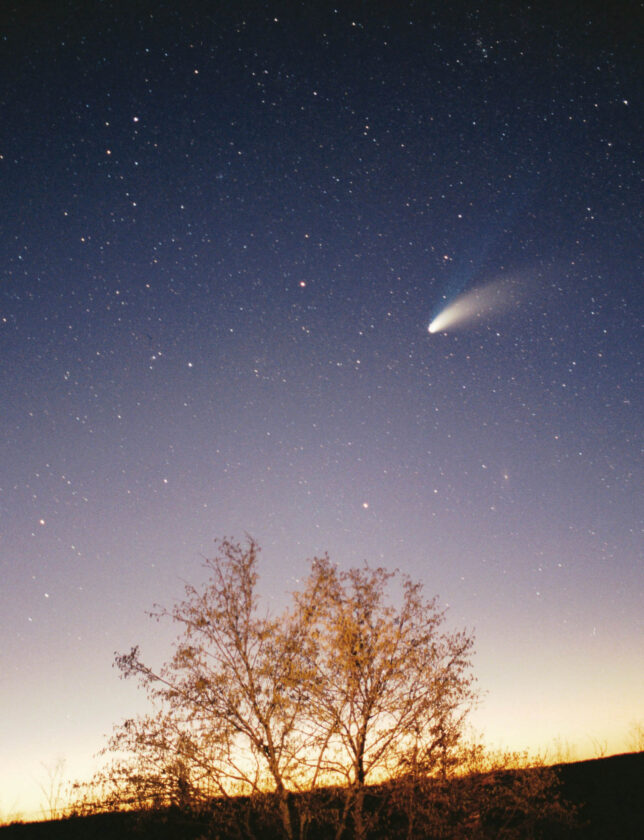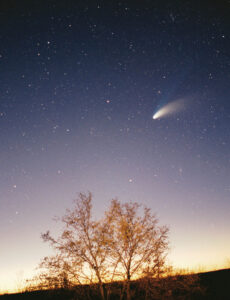Guide to the Adirondack skies: Planets, comets and more

There are two exciting comets that will soon be in the night sky, although you may need a telescope to view them. Image of comet Hale Bopp taken in 1997. (Photo courtesy Wikimedia Commons, Philipp Salzgeber)
The Adirondack Sky Center & Observatory is thrilled to be your guide to the skies. In this column, I’ll be clarifying some of the terms used in astronomy and discussing what will be in the night sky through the end of the year. This includes planets, moons, comets and more.
Some of these objects will be visible to the naked eye, while others will require a telescope for observation. The Sky Center has four high-powered telescopes that are regularly made available to the public during their free observing programs. These are highly weather-dependent, so visit their Facebook page, website or join their mailing list to find out when the next one will be held.
–
Technical terms
–
If you’re interested in what’s visible tonight, a quick Google search might tell you that Saturn is “in Pisces” while the Sun and Moon are “in Virgo.” Additionally, while Saturn is in Pisces, it is also “in opposition,” along with Neptune. I always found these phrases confusing and unhelpful, so what do they really mean?
You’re probably familiar with the constellations. People have imagined shapes made out of the stars for thousands of years. These stars are all around the Earth and so far away that they don’t appear to move over time. We see different constellations throughout the night and the year because the Earth rotates and revolves around the Sun, but the constellations never move relative to each other.
The constellations are stationary, but over the course of many days, the planets, Moon and Sun appear to move relative to them. As they move, they pass in front of different fixed constellations. Saying that Saturn is in Pisces means that Saturn is in front of the constellation Pisces. They will both be overhead at the same time. The Sun is in Virgo, which means that you can’t see Virgo in the night sky right now; it’s only up during the day. The constellations are used as a fixed reference point to describe how other bodies move.
–
Saturn and its moons
–
You may also hear that Saturn is “in opposition,” but opposition to what? Opposition means that Saturn is on the opposite side of the Earth from the Sun. Since it’s away from the Sun, it will be visible all night long. It rises at roughly 7 p.m. and sets at roughly 6:30 a.m. Saturn can be seen with the naked eye, but when using a telescope, its rings and moons appear and are a really special sight. Be sure to look for Titan, Saturn’s largest moon. Titan is the only moon we know of to have a dense atmosphere as well as rivers, lakes and seas of liquid methane on its surface. Astronomers are investigating if it can currently support life. The astronomers at the Adirondack Sky Center would be thrilled to help point it out to you.
–
Jupiter
–
Jupiter can also be seen, but it is not in opposition, so you can only catch it in the early mornings, rising around 1 a.m. If you’re a fan of Jupiter, don’t worry. Over time, objects will rise and set earlier. Jupiter will rise at a more reasonable 8:30 p.m. in November. By January, it will be in opposition and visible all night long.
–
Comets
–
Comets, like planets, orbit the Sun. The major difference is that comets are much smaller and their orbits are far more eccentric, meaning more like ovals than circles. This means they spend most of their time far from the center of the solar system and away from us. They are only close to Earth and visible for short periods.
Currently, there is a comet traveling towards Earth that has the potential to be seen with the naked eye under dark, clear skies. A6 (Lemmon) will be most visible in October, and unless it breaks apart or deviates in its orbit, it should be one of the brightest comets of 2025.
There is only one object in our solar system that doesn’t orbit around the Sun. 3I/ATLAS is an interstellar comet that came from outside our solar system and is just passing through. This is only the third ever object like this we’ve detected. It will be brightest in November, but you will still need a telescope to view this unique object.
From planets to moons, comets to interstellar visitors, the next few months will be very exciting for stargazing. If you’d like to learn more about or see any of these objects for yourself, join the astronomers at the Adirondack Sky Center.
——
Simon Thill is the Associate Director of Astronomy Outreach at the Adirondack Sky Center & Observatory in Tupper Lake. Their organizational vision is to inspire curiosity and provide perspective on our Universe through wonder and enlightenment.




